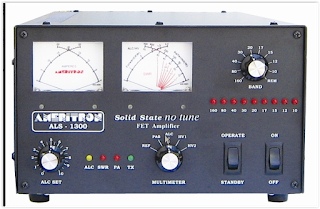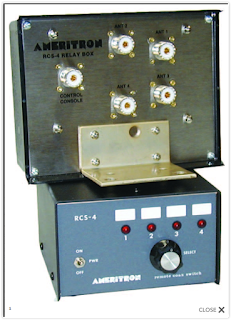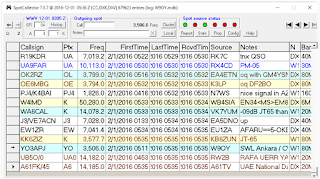I have my radio setup for auto band switching. After Hurricane Matthew tore down my antennas last month I've been in a rebuilding mode. Auto band switching means my amp and antennas band follow my transmitter which is a Flex 6700
All of the antenna cables from the 6700 are represented on a patch panel which resides next to my left leg, screwed to the table underneath the table top. My amps, tuners, power meters, and antenna switch controller all present jacks on my patch panel in a 4 x 8 matrix. My 6300 and 6500 Flex are also represented on the panel. I have a separate panel for switching radio amp signals to my various amps, so its quick work to join The 6700 sends its RF to join a transceiver to a amp to a antenna. My 6700 generally feeds my ALS 1300
That amp generally feeds my MFJ-998
And that feeds either my RCS-4 antenna switch or my G5RV.
It allows me through software and to choose my antenna. I modified the RCS-4 to automatically band follow my radio and the 4 positions allow me to cover 160M, 80M, 40M, and 20M with resonant verticals and I can tune 80M to cover 30M with little loss, and 40M to cover 15M. 80M will also load on 60M efficiently and 12M and 10M will load. 17M is a little flakey. My antenna previous to Matthew was a 65ft vertical, a 130ft inv-L, a half wave 40M end fed vertical and a 5/8 wave on 20M all over 4K feet of ground plane. It was a flame thrower. Today I've rebuilt with a 33 ft vertical using fiberglass telescoping pole. My pole is made from some parts that are very light but strong. I don't use those joiner things just a couple hose clamps, one on the bigger pole to help keep the end from splitting and then some tape on the telescoping piece and another hose clamp compressing the tape. Makes a perfect reliable joint. 2 wires go up the pole, one for 40 and another for 20. To support the pole I pounded in a steel mast like the kind used to telescope for a TV antenna. The vertical slips over the mast and it is both vertical and strong. I have a second shorter pole which starts my 80 and 160 antennas to about 16 feet and then those wires continue up to a branch on a tree where the L goes out to a second tree. These antennas can be lowered in 1 minute.
DXlab is set up so if I click a spot like YO3APJ on 3505, every goes to 3505 and I have a couple tuning macros which allow the tuner to touch up the tuning, and I'm ready to call. I have a macro which puts my transmitter via XIT UP THE BAND by 2 khz to keep from tuning on the DX! I hate that. Not only is it inconsiderate, it shows the tuner upper is a moron since it would be better to tune where you are going to transmit as in the case of a pileup. My setup can tune at about 8 watts of power since the amp is no tune all I have to do is match the antenna. For receive I can move the G5RV feedline from the tuner to the RX2 input on the 6700 and I also have a ALA-100 Welbrook active loop on rxB and I can choose any pair of the receive antennas with my diversity choice on the 6700. I loved the beam forming feature in the 5K and Anan, but I find the diversity setup in the 6700 to be very versatile when it comes to weak signal work. It's easy to write macros in DDUTIL to
click between antenna pairs and compare which pair has the best advantage. I still have a couple more antenna slots to add to the mix
I heard Adrian YO3APJ on calling CQ and working simplex and I'm still trying to see how the new verticals perform, so I gave him a call. Adrian gives honest reports so I knew it would be a good test. Came back as 599 "booming signal" (yep Adrian gives honest reports :) ). The antenna system seems to be shaping up pretty well. The bands have been hot but I seem able to couple adequately into the aether.
73 W9OY





